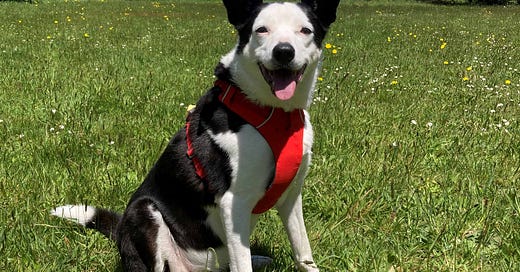This is my park of last resort. It’s a patch of land which sits on the inside of a sharp bend where the road turns almost 180 degrees. I’ve never seen anyone using it, even though I passed it twice a day for years, when I took the bus to work in the city. When there are too many people, and dogs, at the other parks, this one is always empty. When it’s winter and dark before five, it’s close enough to the streetlights for me to feel safe. So, when there’s nowhere else to take my dog, this is where I go.
There’s a reason this patch of land is always empty. Walking to it is hazardous, as it’s on a narrow, winding, busy road with no footpath. There’s nowhere sensible to park a car either. Today, I’ve tucked it in an awkward spot where I know it’s not supposed to be, then crossed the road at the vertex of the curve, with Donna hauling on the lead because she can’t wait to have a run. Any park will do, as far as she’s concerned. Even this one, which used to be a rubbish dump, but was covered over decades ago.
I make her sit and wait while I disconnect the leash, then I let her go. Within seconds, she’s bounding through the grass as if she’s a pup. She’s eleven years old, but she doesn’t seem to know it. Every day is a good day for a run.
I take a slower pace across the park. I’m looking at the plants, because I can no more ignore the plants than forget to breathe. Already, only a few steps in, I can see that the plants are different from the park where I usually take her. It’s only on the other side of the ridge, one gully over, but there are no buttercups, and few dock plants. Their absence tells me that this park is much drier. Instead, the most common yellow flower here is a species called catsear, a type of daisy related to dandelion.
Catsear is the kind of plant which I suspect is invisible to a non-botanist. Along with dandelion, there are numerous different types of yellow-flowered daisies in our lawns, in our parks and on our roadsides, with some delightful names: catsear and oxtongue, hawkbit and hawksbeard, groundsel and ragwort, nipplewort and puha. Unless you are a forager – when the exact species really does matter – there’s no particular reason to distinguish them.





